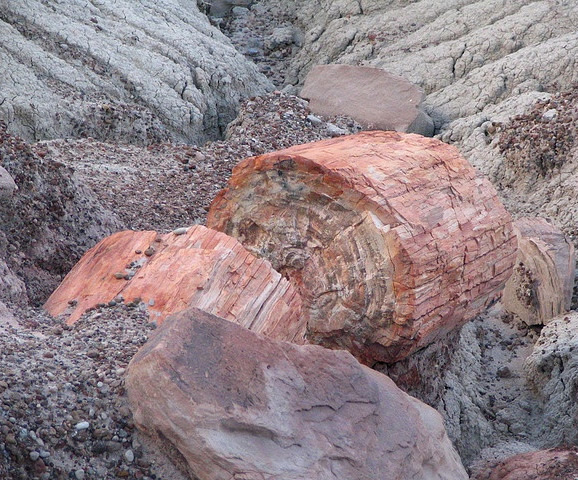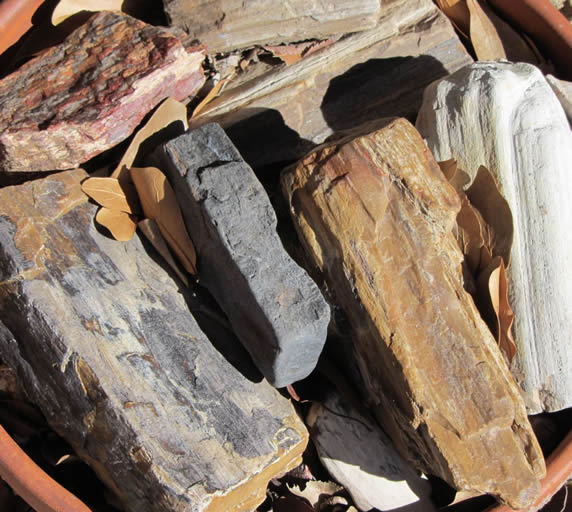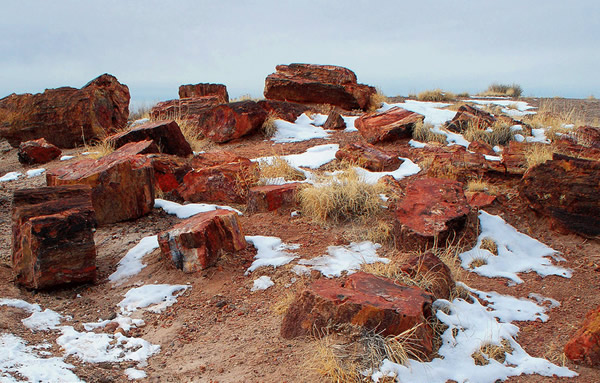 |
| Petrified wood |
Petrified wood is formed by the fossilized remains of ancient trees that were saturated with mineral-filled water which, over time, converted the woody tissues into stone.
Petrified wood is studied by scientists interested in prehistoric plants and their environments. The Latin word petros, meaning rock, is the source for the scientific term petrification. Petrified wood is actually the stone remnant of a prehistoric tree.
Formation
During the Triassic period, gymnosperms—seed-producing trees without flowers, such as gingkos and conifers—grew over much of the earth’s landmass. Volcanic eruptions triggered tremors, lightning, and heavy rains, which washed trees from higher elevations down to swampy valleys.
  |
As they were pushed downhill, the trees were stripped of their bark, branches, and roots from the force of the water’s impact and broke into pieces. Under normal circumstances, trees soaking in deep, muddy water would decay, but silt rapidly and completely covered these trees, preventing exposure to oxygen and inhibiting aerobic decomposition.
Volcanic ash in the floodwater consisted of inorganic compounds such as magnesium carbonate and iron sulphide, and the trees also absorbed silicon dioxide (silica) that had dissolved in groundwater. The minerals filled the spaces between cells in the tree trunks and branches. Molecules of these inorganic materials replaced molecules of organic tissues.
During the next millions of years, wood gradually became stone in the process of silicification. Assisted by extreme pressure and temperatures, the silica that was lodged in the wood was transformed into quartz. Plants that have undergone petrification are also referred to as being permineralized.
The trees remained preserved under the soil for millions of years until soil erosion and shifting plates exposed them. Manganese, lithium, copper, and iron created patterns of bright colors as the wood fossilized. Some petrified wood displays varying rings of vivid colors, resembling agates. Other pieces are brown and look like driftwood.
More significant than its beauty, information about the history of plants on earth is revealed by petrified wood. Unlike other fossils that are seen as an impression or compression, petrified wood is a three dimensional representation of its organic material that preserves its external shape and internal structure.
The preserved tree trunk sections also indicate the size of the Triassic forest. Scientists have even seen chromosomes and stages of nuclear division in petrified cells. A termite nest was discovered in one petrified log, offering clues about that insect’s communal evolution.
Identifying Petrified Wood
 |
| Identifying petrified wood |
Geologists and paleobotanists analyze petrified wood samples to specify the type of ancient tree that became fossilized. The cell structure of hardwood fossils is more diverse than that of softwood trees, causing its source to be more easily identified.
Scientists choose pieces that exhibit an intact cell structure and examine the specimen with a microscope to scrutinize how the wood’s bands and pores are arranged, both of which are crucial identifying characteristics. Softwood samples require greater magnification of thin slivers only one or two cells thick in order to permit enough light to shine through when mounted on a slide.
Wood anatomists then describe the sample’s cell structure, which they compare to records of previously identified petrified wood and existing trees. North Carolina State University and the International Association of Wood Anatomists created a computer database, the General Unknown Entry and Search System (GUESS), which can identify matching cell patterns.
Other databases contain information about existing hardwood and softwood trees; one has information on at least 1,356 types of trees of more than twelve hundred species.
   |
Three types of petrified wood are found in the Tertiary strata. Nondescript silicified wood has undergone silicification but still appears to be woody structurally. Difficult to identify because of its generic structure, nondescript silicified wood requires expert authentication for accurate labeling.
Petrified palm wood has rod structures that reinforced the tissue strength before the wood grain became silicified and that look like spots or lines when the wood is cut. Popular among rock collectors, this type of petrified wood is both Arizona’s state fossil and state rock.
Massive silicified wood is difficult to recognize because the tree’s grain was destroyed during silicification, thus making identification reliant on awareness of the area in which the tree was located and comparison to other petrified wood in adjacent territory.
Petrified Wood in the United States
Wood in Arizona’s Petrified Forest National Park originated from a forest of giant conifer-like trees that grew from Texas to Utah. The park’s 93,533 acres are home to one of the world’s largest assortments of petrified wood.
This desert area is dotted with stone log fragments. Although some visitors expect to see rock trees standing in clumps similar to a natural forest, these petrified trees rest where they fell individually or in groups.
 |
| Petrified wood in Arizona, United States |
Because the ancient forest lived simultaneously with the dinosaurs, archaeologists look for dinosaur fossils near petrified wood in the Arizona park. Although collection and thefts have greatly reduced the number of petrified logs, authorities believe that some areas of the park may shelter petrified wood buried as much as 100 meters beneath the surface.
By the twentieth century, prospectors and tourists had taken the most beautiful pieces; as a result, local residents sought government protection against further theft. In 1906 the petrified wood site was declared a national monument and was named a national park in 1962.
The U.S.National Park Service tries to protect petrified wood by preventing the nearly one million yearly visitors from seizing samples. Rangers patrol sites and ask tourists to report any thefts they witness.
Despite these precautions, several tons of petrified wood disappear annually from the park. Privately owned sites adjacent to the park offer collectors opportunities to search for petrified wood without any restrictions. Stores sell small pieces.
Petrified wood has been discovered in many other regions of the United States, especially in western areas where volcanic activity occurred, such as Yellowstone National Park, and in areas where rivers and streams deposited large amounts of sand, such as Louisiana and Texas. Washington State is home to the Ginkgo Petrified Forest State Park, which contains petrified logs that began fossilizing during the Miocene epoch.
This petrified wood is unique because it includes petrified ginkgo, an indigenous tree that no longer grows naturally there. An unusual type of petrified wood that resembles pebbles and that originated in the Chehalis Valley is sometimes seen on the state’s beaches.
The Calistoga, California, petrified forest is considered one of the best sources of Pliocene fossils similar to existing redwoods. Measuring more than 2 meters in diameter, the fossil logs reveal gray stone veins of quartz.
Petrified wood in New Mexico’s Bisti Badlands is not as colorful as neighboring Arizona’s fossil wood. In Utah, petrified wood has been found near the Escalante River and the Coyote Buttes region near the Paria River. Petrified wood has also been found in Mississippi and Alabama.
Petrified Wood Worldwide
A petrified forest on the Greek island of Lesbos was named a protected site by presidential decree. Scientists have determined that the petrified wood began fossilizing during the Late Oligocene to Lower-Middle Miocene epochs.
Unlike other sites of petrified forests, the Lesbos fossil trunks are erect and still have intact roots penetrating into fossilized soil, branches, leaves, cones, and seeds.
These trees were fossilized where they grew, of fering insight into the environment and climate of ancient Lesbos. The ancient trees were well preserved during the petrification process, and such details as rings indicating age and growth patterns are visible.
Both gymnosperms and angiosperms (flowering plants) grew in the ancient forests, along with pteridophytes such as ferns. Many of these ancient species no longer grow in the Mediterranean.
Instead, they are found in Asian and American tropical and subtropical regions, indicating that Lesbos’s petrified forest presents information about how life on earth evolved as the continents moved apart.
Other sites of fossilized wood also reveal details about the planet’s development. Argentina’s Petrified Forest on the Central Steppes was created after the formation of the Andes Mountains.
Larger than American wood fossils, Argentinean petrified wood includes pieces 27 meters long and 3 meters in diameter. The petrified forest in Namibia contains giant tree trunks as long as 30meters. Petrified wood has also been discovered in Australia, India, England, Turkey, and Switzerland.
Petrified Wood’s Legacy
Paleobotanists research petrified wood to determine how the earth and the plants that have grown on its surface have changed since ancient times. They study how plants are related and descended from similar ancestors.
Throughout history, many more tree species have existed than are documented, and many species, existing and extinct, await discovery. Pieces of fossil wood are often the oldest known specimens of a tree species and might be the predecessors of living trees.
Petrified wood helps researchers comprehend how trees have evolved to adapt to environmental and climatic conditions. For example, researchers have hypothesized that the cell structure of tree xylem has not changed as much as fruit and leaves. Fossil wood sometimes reveals the reason for the demise of extinct trees.
The study of petrified wood has altered how scientists perceive both ancient geological ecosystems and modern environments by offering perspective on which plants lived on the earth and survived, adapted, or died according to changes in the atmosphere and crust.